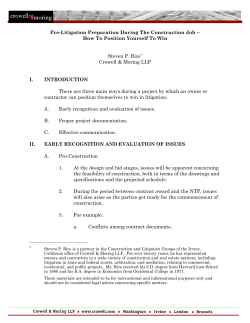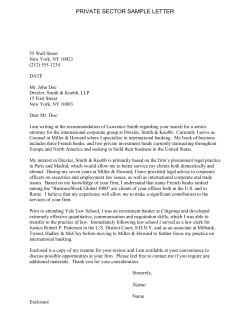
LITIGATION FUNDING LITIGATION
October 2012 LITIGATION LITIGATION FUNDING The recent decision of the Court of Appeal in Contractors Bonding Ltd v Waterhouse has brought some clarity to the issues surrounding the court’s role in supervising third-party litigation funding. Third-party commercial funding for litigation is a recent phenomenon in the New Zealand legal scene, with a number of firms setting up in this country to offer funding for the whole range of expenses associated with bringing legal claims. A key issue is the court’s role in supervising funding arrangements and the extent to which the funding agreement needs to be disclosed to the defendant. Defendants have a legitimate interest in the plaintiff’s funding arrangements, so that they can manage exposure to unmeritorious claims and ensure that the plaintiff and its funders are subject to the important incentives created by costs consequences. Strategically minded defendants are also interested in knowing about the plaintiffs’ funding arrangements, so as to be able to undermine them and potentially defeat even meritorious claims through satellite litigation. A recent decision of the Court of Appeal has brought some clarity to this area. An earlier decision of that Court, involving a representative action on behalf of 1,800 Feltex shareholders, had left open questions about the extent of the court’s role in overseeing litigation funding where group litigation is not involved. Now, in Contractors Bonding Ltd v Waterhouse [2012] NZCA 399, the Court of Appeal has confirmed that the court has a function in overseeing third-party funding in all types of proceedings, and has articulated some general requirements about disclosure of funding agreements. This FYI explores the concept of litigation funding, the nature of the court’s oversight role, and the level of detail required to be disclosed about a funding arrangement. It also looks at some issues still to be resolved. www.simpsongrierson.com What is litigation funding? In general terms, litigation funding involves a third-party commercial funder paying the cost of litigation for a plaintiff in exchange for an agreed portion of any judgment or settlement received if the plaintiff’s claim succeeds. Typically, the funding covers not only the party’s own legal fees and disbursements, but adverse costs awards and the need to pay security for costs to the defendant. If the plaintiff is unsuccessful, the funder recovers nothing. Litigation funding has been slow to take off in New Zealand compared to other jurisdictions but has become increasingly common, in large part due to the Global Financial Crisis and the failure of numerous New Zealand finance companies and other corporations. The failures have left behind a trail of disappointed investors for whom, without litigation funding, legal action might otherwise not be attractive or financially possible. The courts have been prepared to endorse third-party funding because of its role in providing access to justice: In an age where the costs of litigation are beyond the means of many people, professional funders undoubtedly have an increasingly important role to play in ensuring that legal obligations and rights are enforced and vindicated.1 Haven’t litigation funders always been around? Until relatively recently, the courts frowned upon litigation funding as a commercial enterprise. The torts of maintenance and champerty, developed by the English courts around 300 1 Houghton v Saunders (2008) 19 PRNZ 173 (HC) at [177] 01 years ago, prevented parties becoming involved in litigation that was of no direct concern to them in order to protect the integrity of the court process. Although maintenance and champerty have now been abolished by legislation in England & Wales and Australia, no such statute has been passed here and the New Zealand Law Commission has recommended retaining the torts. Judicial support and oversight of litigation funding arrangements Notwithstanding that maintenance and champerty continue to be a part of our system of law, judicial support for litigation funding has occurred at a high level. In the 2009 Court of Appeal decision in Saunders v Houghton [2010] 3 NZLR 331, shareholders of Feltex Carpets brought proceedings against the directors, promoters and other signatories to Feltex’s prospectus and investment statements. The claim was a representative action - that is, the plaintiff sued on behalf of other parties with the same interest in the plaintiff’s claim. This decision indicated that litigation funding is unlikely to be condemned as unlawful maintenance and champerty where: a. The court is satisfied that there is an arguable case for rights that warrant vindicating. b.There is no abuse of process. This involves looking at the funder’s degree of control over the litigation, the level of profit it stands to gain and the nature of its interest in the litigation. c. The funding proposal is approved by the court. Because the claim in the Feltex case was a representative action, the High Court Rules had necessitated an application for court approval of its representative character at the outset of the proceeding. The issues about the funding arrangement arose in the context of this procedural step. What was left unclear as a result of the decision was whether the Court of Appeal’s comments were of general application, or only arose in the context of litigation funding for group claims. Saunders revisited - Contractors Bonding In Contractors Bonding, the Court of Appeal addressed the issue left open by its decision in Saunders. The Court held that it did have a function in assessing third-party funding arrangements in all cases, notwithstanding the absence of any specific rule in the High Court Rules requiring such arrangements to be put before the court. Because third-party funding arrangements, both in ordinary claims and in representative actions, are on their face champertous, this warrants an assessment in each case of whether the arrangements are in fact lawful. a. Giving formal notice to the court and the non-funded party that a litigation funder is involved. This notice should be given at the time proceedings are commenced or otherwise when a litigation funder first becomes involved. b. Providing the non-funded party with the following key details of the funding agreement: i. the identity and location of the funder; ii. the funder’s financial standing and ability to fund the case through to trial; iii.the funder’s amenability to the jurisdiction of the New Zealand courts; and iv.the terms on which funding can be withdrawn and the consequences of withdrawal. In practice, this may involve providing the non-funded party with a copy of the funding agreement, though the decision contemplates redactions of information which could confer a tactical advantage to the non-funded party, such as information about the size of the ‘war chest’ or other commercially sensitive or privileged details. The Court noted that the practice in the Australian Federal Court is for funded parties to redact such information from disclosure copies of their funding agreements. Early disclosure of funding agreements is already a routine feature of Australian representative actions. In fact, as the Court of Appeal noted, some Australian commercial funders choose to publicly disclose their funding agreements on their websites, including their usual commission rates, and will provide sample agreements upon request. Issues still to be resolved While Contractors Bonding brings some welcome clarity to the area, New Zealand’s common law relating to litigation funding is still in its infancy. Two headline issues still to be canvassed thoroughly concern the extent to which it is appropriate for funders to exercise control over the conduct of the litigation and the appropriate level of profit for the funder if the claim is successful. Regulation of some form is in the pipeline, in the form of the draft Class Actions Bill and High Court Rules. Progress has however been slow. Drafts prepared in 2008 are currently sitting with the Ministry of Justice. Moreover, the draft Bill and the draft Rules only relate to litigation funding in the context of class actions, which will lead to exactly the same sort of uncertainty that Contractors Bonding needed to resolve following the Feltex decision. Overall the subject calls for comprehensive regulation, rather than piecemeal development through the courts, but at the moment it’s a matter of watching this space. Assessment of a funding arrangement must necessarily involve disclosure of some elements of the funding agreement. The Court held that this will involve the funded party: www.simpsongrierson.com 02 CONTACT DETAILS WILLIAM AKEL – PARTNER T. 09 977 5090 M. 021 987 058 E. william.akel@simpsongrierson.com JAMES CAIRD– PARTNER T. 09 977 5187 M. 021 582 673 E. james.caird@simpsongrierson.com ANNE CALLINAN – PARTNER T. 09 977 5031 M. 021 403 592 E. anne.callinan@simpsongrierson.com GRAEME CHRISTIE – PARTNER T. 09 977 5074 M. 021 960 493 E. graeme.christie@simpsongrierson.com JAMES CRAIG – PARTNER T. 09 977 5125 M. 021 497 713 E. james.craig@simpsongrierson.com ROBERT GAPES – PARTNER T. 09 977 5076 M. 021 935 415 E. robert.gapes@simpsongrierson.com RICHARD LANGE – PARTNER T. 09 977 5013 M. 029 977 5013 E. richard.lange@simpsongrierson.com MICHAEL ROBINSON – PARTNER T. 09 977 5297 M. 021 505 581 E. michael.robinson@simpsongrierson.com JOHN SHACKLETON – PARTNER T. 04 924 3540 M. 029 924 3540 E. john.shackleton@simpsongrierson.com TIM STEPHENS – PARTNER T. 04 924 3525 M. 021 720 920 E. tim.stephens@simpsongrierson.com BEN UPTON – PARTNER T. 09 977 5207 M. 021 538 847 E. ben.upton@simpsongrierson.com TRACEY WALKER – PARTNER T. 09 977 5088 M. 021 273 6241 E. tracey.walker@simpsongrierson.com A SIMPSON GRIERSON PUBLICATION This newsletter is produced by Simpson Grierson. It is intended to provide general information in summary form. The contents do not constitute legal advice and should not be relied on as such. Specialist legal advice should be sought in particular matters. © Copyright Simpson Grierson 2012. www.simpsongrierson.com 03
© Copyright 2025




















![—Not Warranting it’s adequate in ... [Sample Litigation Hold Letter from ... case, but it’s an example]](http://cdn1.abcdocz.com/store/data/000030073_2-6c36fd0490099ab95b4eb05c9c11a0b9-250x500.png)
